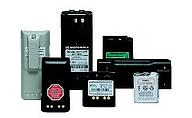Many of the questions we get asked on a regular basis involve batteries for two-way radios. What battery is better for my radio? How do I know when to replace my battery? What is the proper way to charge a battery? Today we are going to dissect different battery terminology and questions for you. In a previous blog post we covered the proper way to charge and care for your battery so we won't cover that today but check the link to read all about it.
1 - How do I know when my battery needs to be replaced?
On average, two-way radio batteries will have a life of 18-24 months. This will vary based upon usage, charging habits etc. On Motorola batteries, there is a date code that will tell you when the battery was manufactured. The first digit represents the last digit of the year of manufacture and the next two digits represent the week number of that year. For example, 952 would mean that the battery was manufactured the last week of December in 2009.
Another way to tell that you two-way radio battery needs to be replaced is when you turn your radio on and you hear a series of short beeps or you hear short beeps when you try to transmit. A third way to tell that your battery needs to be replaced is when it no longer holds a charge. For example, your fully charged battery that previously lasted 6-8 hours is now only lasting 1-2 hours (these numbers are just for example purposes).
2 - What is the difference between the three main battery types available for two-way radios?
NiCd, NiMH and Li-Ion are the three main types of batteries available for two-way radios that are regularly used. According to Motorola, "Nickel cadium (NiCd) batteries are the most cost-effective option because they provide a longer cycle life. They're ideal for radio users who work in extreme conditions of cold and heat (-30C to +50C). However, NiCd batteries can experience "memory effect" and may not return to full capacity if they're recharged before being fully discharged. Motorola goes on to say "Nickel-Metal Hydride (NiMH) batteries, compared to NiCd batteries of similar size, usually operate 40-50% longer between charges. However, they do not operate as efficiently in extreme temperatures. Also, NiMH batteries are more environmentally friendly because they contain fewer toxic chemicals. Lastly, Motorola describes Lithium-Ion (Li-Ion) batteries as "offering the best of both worlds by providing a higher energy-to-weight ration than NiMH batteries and they offer a major advantage by not experiencing "memory effect".
So, bottom line, when choosing the type of batteries to purchase your first step is to evaluate yo ur company's needs. Feel free to ask any of our expert engineers or certified sales reps for assistance in choosing.
ur company's needs. Feel free to ask any of our expert engineers or certified sales reps for assistance in choosing.
3 - How do I dispose of my batteries when they are no longer useful?
These types of batteries should not be disposed of in your regular garbage. There are many places that will recycle them for you. Telecom is a battery recycling center so send them to us in our Long Island office (234 Newtown Rd. Plainview, NY 11803) or stop by and drop them off and we will happily recycle them for you.
Your two-way radios will only work as good as your batteries so make sure to choose the appropriate type as well as charging and storing them correctly. If you would like to learn more about how Motorola batteries compare to others download the Motorola Proven Tough white paper

